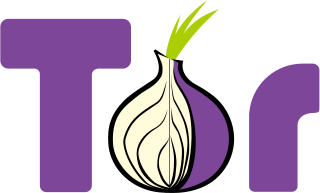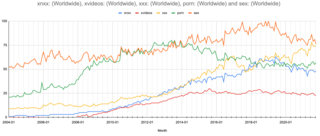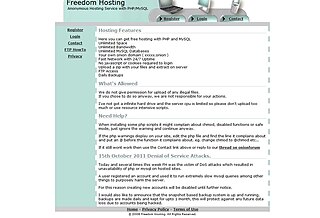The deep web, invisible web, or hidden web are parts of the World Wide Web whose contents are not indexed by standard web search-engine programs. This is in contrast to the "surface web", which is accessible to anyone using the Internet. Computer scientist Michael K. Bergman is credited with inventing the term in 2001 as a search-indexing term.
A dark net or darknet is an overlay network within the Internet that can only be accessed with specific software, configurations, or authorization, and often uses a unique customized communication protocol. Two typical darknet types are social networks, and anonymity proxy networks such as Tor via an anonymized series of connections.
Rape pornography is a subgenre of pornography involving the description or depiction of rape. Such pornography either involves simulated rape, wherein sexually consenting adults feign rape, or it involves actual rape. Victims of actual rape may be coerced to feign consent such that the pornography produced deceptively appears as simulated rape or non-rape pornography. The depiction of rape in non-pornographic media is not considered rape pornography. Simulated scenes of rape and other forms of sexual violence have appeared in mainstream cinema, including rape and revenge films, almost since its advent.

.onion is a special-use top-level domain name designating an anonymous onion service, which was formerly known as a "hidden service", reachable via the Tor network. Such addresses are not actual DNS names, and the .onion TLD is not in the Internet DNS root, but with the appropriate proxy software installed, Internet programs such as web browsers can access sites with .onion addresses by sending the request through the Tor network.
Internet censorship in the United Kingdom is conducted under a variety of laws, judicial processes, administrative regulations and voluntary arrangements. It is achieved by blocking access to sites as well as the use of laws that criminalise publication or possession of certain types of material. These include English defamation law, the Copyright law of the United Kingdom, regulations against incitement to terrorism and child pornography.
Porn 2.0, named after “Web 2.0”, refers to pornographic websites featuring user-generated content, including social networking features such as user-based categorizing, webcam hosting, blogs and comments. This is in contrast to the static content offered by “Web 1.0” porn sites. Porn 2.0 sites may offer features similar to mainstream Web 2.0 services such as video communities, social sites,, general blogging platforms, and photo hosting services.
Amateur pornography is a category of pornography that features models, actors or non-professionals performing without pay, or actors for whom this material is not their only paid modeling work. Reality pornography is professionally made pornography that seeks to emulate the style of amateur pornography. Amateur pornography has been called one of the most profitable and long-lasting genres of pornography.

Tor is a free overlay network for enabling anonymous communication. Built on free and open-source software and more than seven thousand volunteer-operated relays worldwide, users can have their Internet traffic routed via a random path through the network.

Internet pornography is any pornography that is accessible over the Internet; primarily via websites, FTP connections, peer-to-peer file sharing, or Usenet newsgroups. The greater accessibility of the World Wide Web from the late 1990s led to an incremental growth of Internet pornography, the use of which among adolescents and adults has since become increasingly popular.

The Hidden Wiki was a dark web MediaWiki wiki operating as a Tor hidden service that could be anonymously edited after registering on the site. The main page served as a directory of links to other .onion sites.

Freedom Hosting was a Tor specialist web hosting service that was established in 2008. At its height in August 2013, it was the largest Tor web host.
The dark web is the World Wide Web content that exists on darknets: overlay networks that use the Internet but require specific software, configurations, or authorization to access. Through the dark web, private computer networks can communicate and conduct business anonymously without divulging identifying information, such as a user's location. The dark web forms a small part of the deep web, the part of the web not indexed by web search engines, although sometimes the term deep web is mistakenly used to refer specifically to the dark web.
The precise number of websites blocked in the United Kingdom is unknown. Blocking techniques vary from one Internet service provider (ISP) to another with some sites or specific URLs blocked by some ISPs and not others. Websites and services are blocked using a combination of data feeds from private content-control technology companies, government agencies, NGOs, court orders in conjunction with the service administrators who may or may not have the power to unblock, additionally block, appeal or recategorise blocked content.

Doxbin was an onion service. It was a pastebin primarily used by people posting personal data of any person of interest.
A darknet market is a commercial website on the dark web that operates via darknets such as Tor and I2P. They function primarily as black markets, selling or brokering transactions involving drugs, cyber-arms, weapons, counterfeit currency, stolen credit card details, forged documents, unlicensed pharmaceuticals, steroids, and other illicit goods as well as the sale of legal products. In December 2014, a study by Gareth Owen from the University of Portsmouth suggested the second most popular sites on Tor were darknet markets.
Operation Torpedo was a 2011 operation in which the Federal Bureau of Investigation (FBI) compromised three different hidden services hosting child pornography, which would then target anyone who happened to access them using a network investigative technique (NIT).
Playpen was a notorious darknet child pornography website that operated from August 2014 to March 2015. The website operated through the Tor network which allowed users to use the website anonymously. After running the website for 6 months, the website owner Steven W. Chase was captured by the FBI. After his capture, the FBI continued to run the website for another 13 days as part of Operation Pacifier.
Childs Play [sic] was a website on the darknet featuring child sexual abuse material that operated from April 2016 to September 2017, which at its peak was the largest of its class. The site was concealed by being run as a hidden service on the Tor network. After running the site for the first six months, owner Benjamin Faulkner of North Bay, Ontario, Canada, was captured by the United States Department of Homeland Security. For the remaining eleven months the website was owned and operated by the Australian Queensland Police Service's Task Force Argos, as part of Operation Artemis.
Boystown was a child pornography website run through the Tor network as an onion service.





